Abstract
There are numerous pesticides and toxic chemicals in the environment that have yet to be evaluated for potential to cause developmental neurotoxicity. Recent legislation and testing initiatives provide an impetus to generating more information about potential hazards to children. In the United States, the 1996 Food Quality Protection Act (FQPA) required the U.S. Environmental Protection Agency (U.S. EPA) to make a finding that a pesticide food use is safe for children. In addition, the law requires U.S. EPA to incorporate an additional 10-fold factor in risk assessments for pesticide residue tolerances to take into account the special sensitivities of infants and children as well as incomplete data with respect to toxicity and exposures. The potential of chemicals in food and drinking water to cause endocrine disruption will also be examined via the Endocrine Disruptor Screening and Testing Program required by the FQPA and the 1996 Safe Drinking Water Act. In addition, a new voluntary chemical information program will provide screening-level information for the some 2,800 high-volume chemicals in commerce in the United States. These initiatives will need to be accompanied by research focused on developmental toxicity for children, including developmental disabilities. Developmental disabilities exact a large toll on children's health in the United States. Three major developmental disabilities--autism, cerebral palsy, and severe mental retardation--each affect substantial numbers of children. We know very little about the etiology of these conditions. A number of priority areas for research are suggested, including a large environmental prospective study of developmental neurotoxicity.
Full text
PDF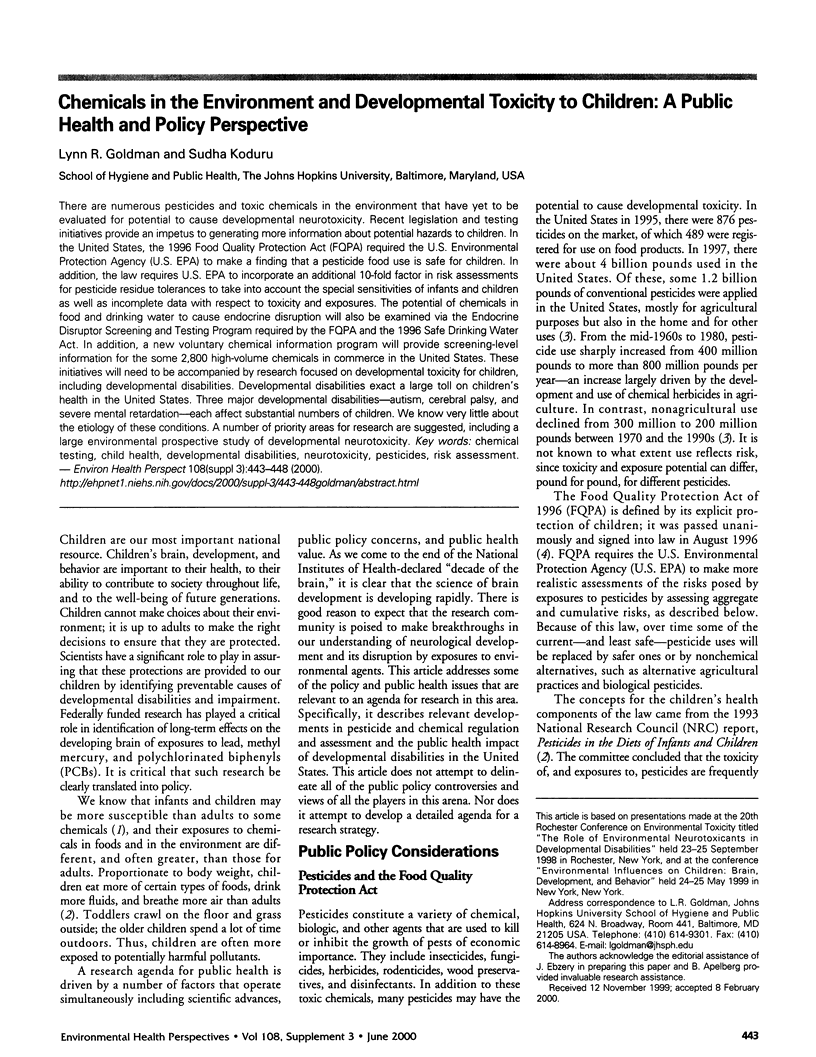
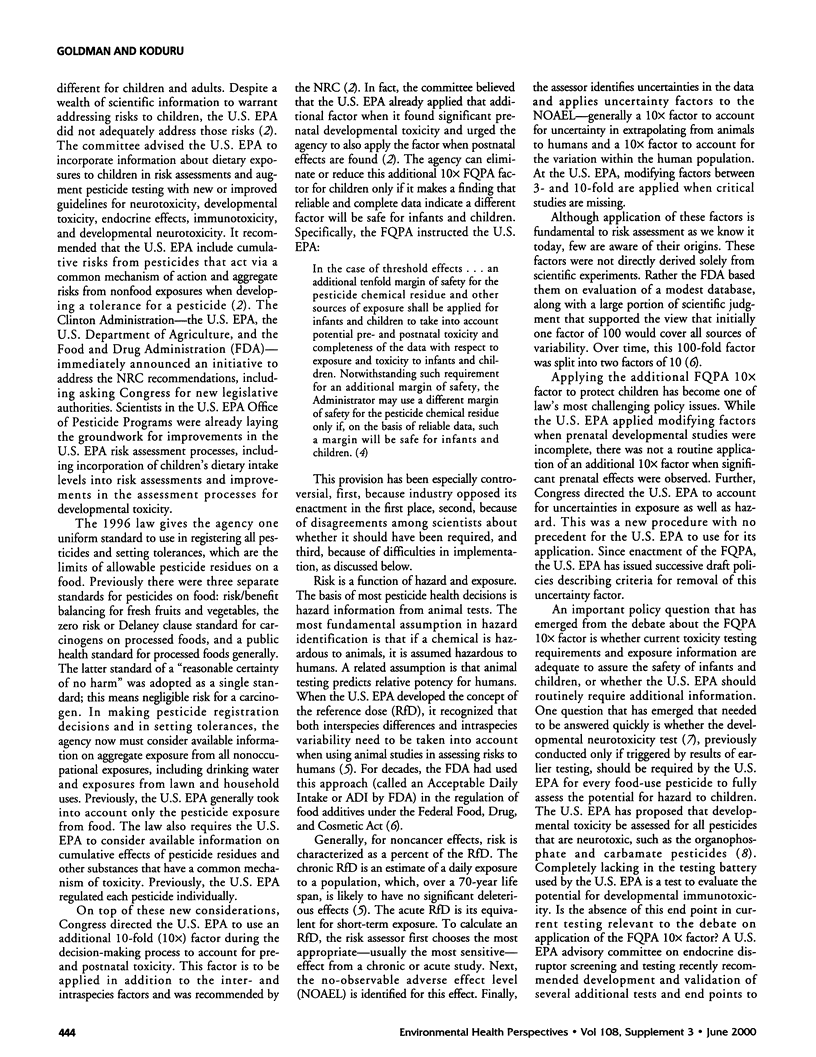
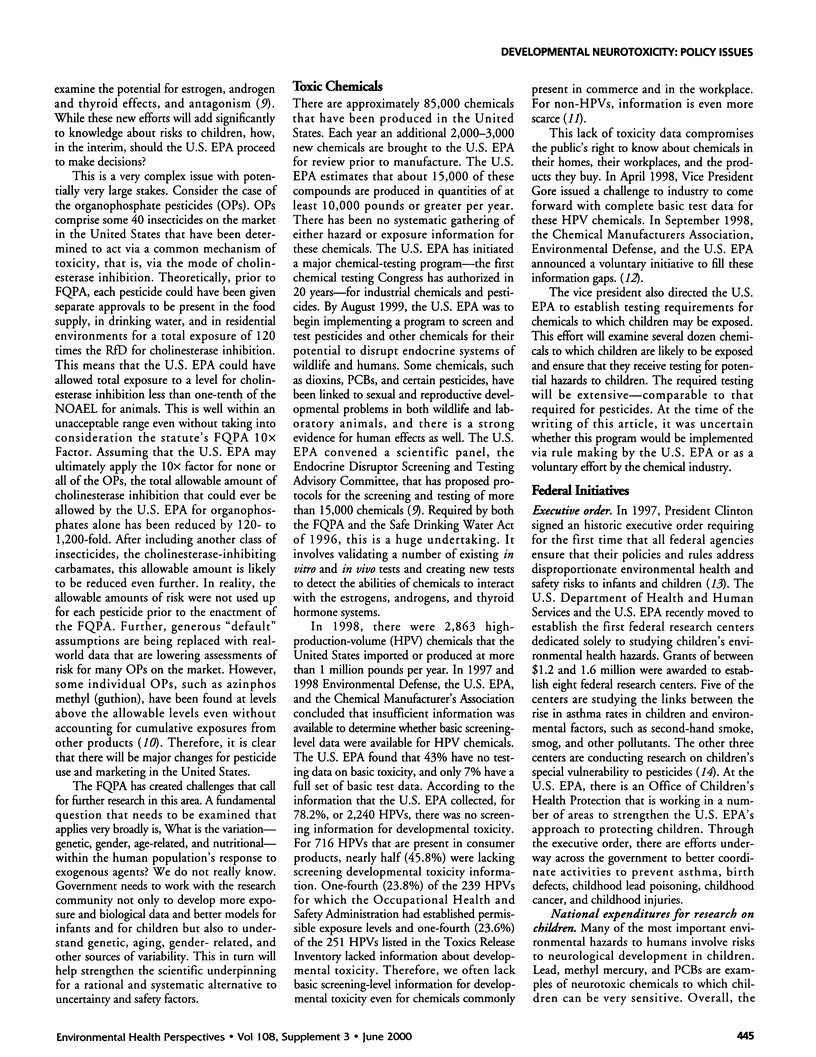
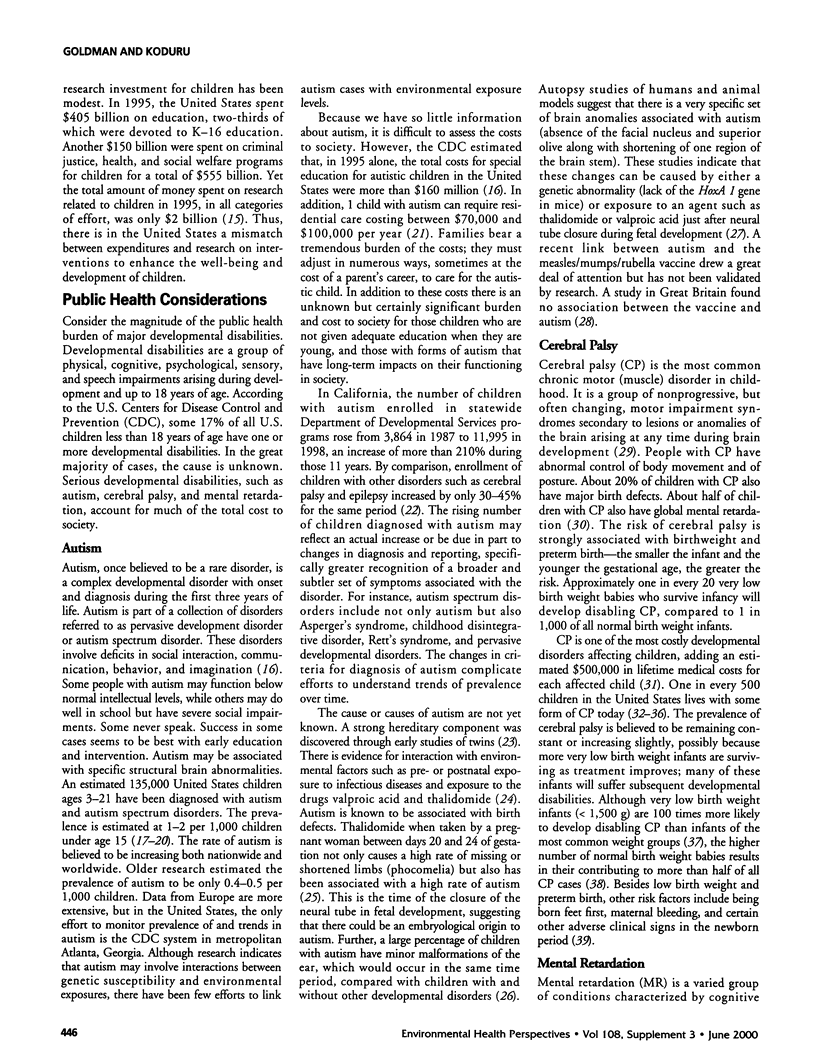
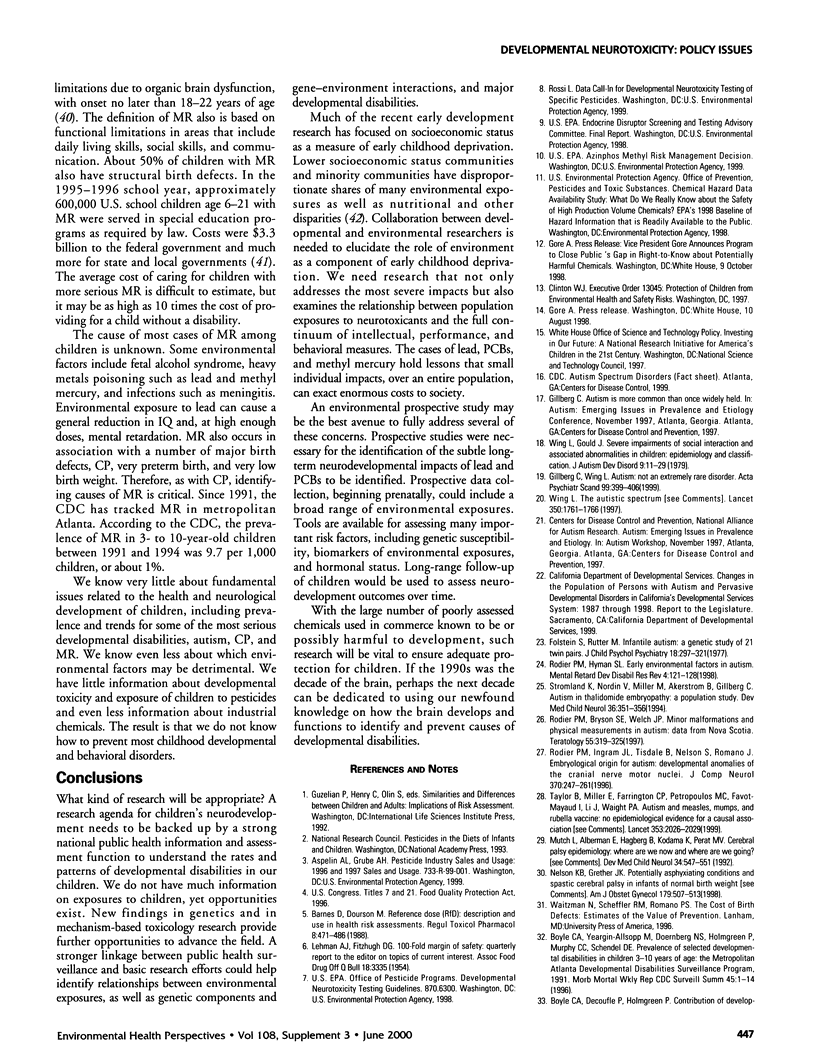
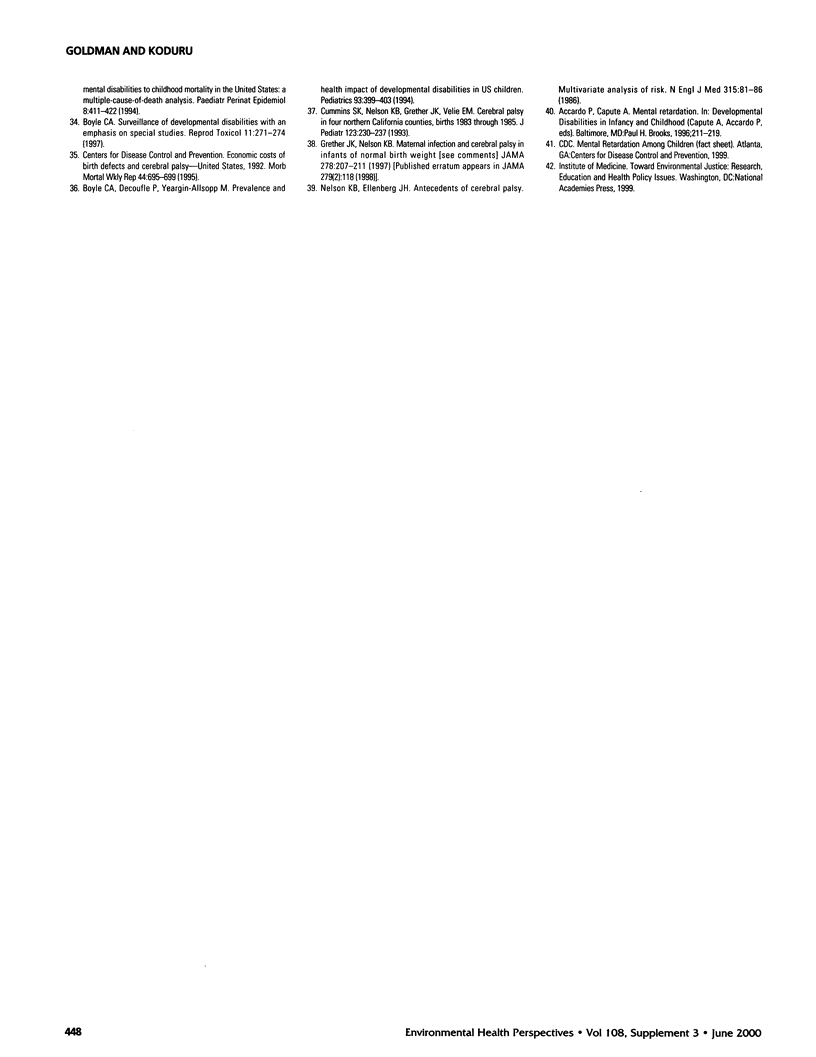
Selected References
These references are in PubMed. This may not be the complete list of references from this article.
- Barnes D. G., Dourson M. Reference dose (RfD): description and use in health risk assessments. Regul Toxicol Pharmacol. 1988 Dec;8(4):471–486. doi: 10.1016/0273-2300(88)90047-5. [DOI] [PubMed] [Google Scholar]
- Boyle C. A., Decouflé P., Holmgreen P. Contribution of developmental disabilities to childhood mortality in the United States: a multiple-cause-of-death analysis. Paediatr Perinat Epidemiol. 1994 Oct;8(4):411–422. doi: 10.1111/j.1365-3016.1994.tb00480.x. [DOI] [PubMed] [Google Scholar]
- Boyle C. A., Decouflé P., Yeargin-Allsopp M. Prevalence and health impact of developmental disabilities in US children. Pediatrics. 1994 Mar;93(3):399–403. [PubMed] [Google Scholar]
- Boyle C. A. Surveillance of developmental disabilities with an emphasis on special studies. Reprod Toxicol. 1997 Mar-Jun;11(2-3):271–274. doi: 10.1016/s0890-6238(96)00144-x. [DOI] [PubMed] [Google Scholar]
- Boyle C. A., Yeargin-Allsopp M., Doernberg N. S., Holmgreen P., Murphy C. C., Schendel D. E. Prevalence of selected developmental disabilities in children 3-10 years of age: the Metropolitan Atlanta Developmental Disabilities Surveillance Program, 1991. MMWR CDC Surveill Summ. 1996 Apr 19;45(2):1–14. [PubMed] [Google Scholar]
- Cummins S. K., Nelson K. B., Grether J. K., Velie E. M. Cerebral palsy in four northern California counties, births 1983 through 1985. J Pediatr. 1993 Aug;123(2):230–237. doi: 10.1016/s0022-3476(05)81693-2. [DOI] [PubMed] [Google Scholar]
- Fleming H. E., Hall M. G., Dolan M. J., Paul J. P. Quality framework for force plate testing. Proc Inst Mech Eng H. 1997;211(3):213–219. doi: 10.1243/0954411971534322. [DOI] [PubMed] [Google Scholar]
- Folstein S., Rutter M. Infantile autism: a genetic study of 21 twin pairs. J Child Psychol Psychiatry. 1977 Sep;18(4):297–321. doi: 10.1111/j.1469-7610.1977.tb00443.x. [DOI] [PubMed] [Google Scholar]
- Gillberg C., Wing L. Autism: not an extremely rare disorder. Acta Psychiatr Scand. 1999 Jun;99(6):399–406. doi: 10.1111/j.1600-0447.1999.tb00984.x. [DOI] [PubMed] [Google Scholar]
- Grether J. K., Nelson K. B. Maternal infection and cerebral palsy in infants of normal birth weight. JAMA. 1997 Jul 16;278(3):207–211. [PubMed] [Google Scholar]
- Mutch L., Alberman E., Hagberg B., Kodama K., Perat M. V. Cerebral palsy epidemiology: where are we now and where are we going? Dev Med Child Neurol. 1992 Jun;34(6):547–551. doi: 10.1111/j.1469-8749.1992.tb11479.x. [DOI] [PubMed] [Google Scholar]
- Nelson K. B., Ellenberg J. H. Antecedents of cerebral palsy. Multivariate analysis of risk. N Engl J Med. 1986 Jul 10;315(2):81–86. doi: 10.1056/NEJM198607103150202. [DOI] [PubMed] [Google Scholar]
- Nelson K. B., Grether J. K. Potentially asphyxiating conditions and spastic cerebral palsy in infants of normal birth weight. Am J Obstet Gynecol. 1998 Aug;179(2):507–513. doi: 10.1016/s0002-9378(98)70387-4. [DOI] [PubMed] [Google Scholar]
- Rodier P. M., Bryson S. E., Welch J. P. Minor malformations and physical measurements in autism: data from Nova Scotia. Teratology. 1997 May;55(5):319–325. doi: 10.1002/(SICI)1096-9926(199705)55:5<319::AID-TERA4>3.0.CO;2-U. [DOI] [PubMed] [Google Scholar]
- Rodier P. M., Ingram J. L., Tisdale B., Nelson S., Romano J. Embryological origin for autism: developmental anomalies of the cranial nerve motor nuclei. J Comp Neurol. 1996 Jun 24;370(2):247–261. doi: 10.1002/(SICI)1096-9861(19960624)370:2<247::AID-CNE8>3.0.CO;2-2. [DOI] [PubMed] [Google Scholar]
- Strömland K., Nordin V., Miller M., Akerström B., Gillberg C. Autism in thalidomide embryopathy: a population study. Dev Med Child Neurol. 1994 Apr;36(4):351–356. doi: 10.1111/j.1469-8749.1994.tb11856.x. [DOI] [PubMed] [Google Scholar]
- Taylor B., Miller E., Farrington C. P., Petropoulos M. C., Favot-Mayaud I., Li J., Waight P. A. Autism and measles, mumps, and rubella vaccine: no epidemiological evidence for a causal association. Lancet. 1999 Jun 12;353(9169):2026–2029. doi: 10.1016/s0140-6736(99)01239-8. [DOI] [PubMed] [Google Scholar]
- Wing L., Gould J. Severe impairments of social interaction and associated abnormalities in children: epidemiology and classification. J Autism Dev Disord. 1979 Mar;9(1):11–29. doi: 10.1007/BF01531288. [DOI] [PubMed] [Google Scholar]
- Wing L. The autistic spectrum. Lancet. 1997 Dec 13;350(9093):1761–1766. doi: 10.1016/S0140-6736(97)09218-0. [DOI] [PubMed] [Google Scholar]


